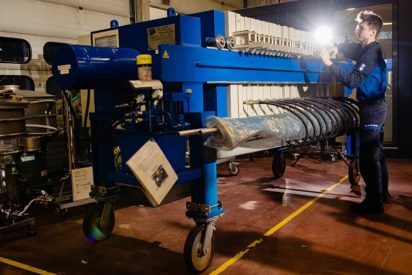Additional processes analysis equipment to simplify and make fermentation and purification of intracellularly formed products more efficient.
Proces- en analyseapparatuur voor het vereenvoudigen en efficiënter maken van fermentaties en de opzuivering van intracellulair gevormde producten.
Text in Dutch: see below
Supported by – Met de steun van:
European Fund for Regional Development – Europees Fonds voor Regionale Ontwikkeling
Fonds voor Innoveren en Ondernemen (FIO) – Fund for Innovation and Entrepreneurship


Depending on the microorganism and the genetic modification, the desired molecules produced during fermentation are either formed within the cell (intracellular) or transported through the cell wall (extracellular). In the latter case, the desired products end up in the fermentation medium, from where they can easily be recovered after separation from the cells. However, in the case of intracellular production, the cell walls must first be disrupted to release the products. The breaking open of microbial cells (lysis) can occur in different ways, depending on the type of microorganism and the product. There are mechanical (e.g. sonication, high pressure homogenization, ball mill), chemical (e.g. detergents, osmotic cell lysis) and enzymatic methods. This releases the entire cell contents, which greatly complicates further purification. Monitoring the preceding fermentation process is also less obvious.
Unlike many other sectors, in industrial biotech only a limited number of parameters are monitored online. However, to date, crucial process parameters have typically been measured offline. To enable automation and data analysis and bridge the gap to an ‘industrial biotechnology 4.0’, advanced sensors for online measurements of certain process parameters are indispensable, especially in the case of intracellular products.
By investing in a widely applicable fermentation sensor with analysis system for in-situ, real-time measurement and analysis of multiple products, nutrients and metabolites in parallel, BBEPP meets the needs of partners who want to gain deeper insight into their fermentation process, or themselves want to implement such technologies to, for example, reduce intensive analysis. On the other hand, BBEPP can use such sensors to optimize or standardize fermentations (mainly complex intracellular, demonstration-scale projects or during large campaigns).
With Bio Base Release, BBEPP invests in specialized and state-of-the-art process equipment for, on the one hand, the process control and monitoring of (intracellular) fermentations, and on the other hand, in equipment to break open the cells and equipment to subsequently further fractionate and purify the desired product out of the mix of cell contents and fermentation medium.
————————————————————————————————————————————————————-
Afhankelijk van het micro-organisme en de genetische modificatie, worden tijdens fermentaties de gewenste moleculen ofwel binnen de cel gevormd (intracellulair), ofwel doorheen de celwand getransporteerd (extracellulair). In dat laatste geval komen de gewenste producten in het fermentatiemedium terecht, van waaruit ze eenvoudig kunnen worden geanalyseerd en opgezuiverd na afscheiding van de cellen. Echter, in het geval van intracellulaire productie, dienen de celwanden eerst te worden opengebroken om de producten vrij te stellen. Het openbreken van microbiële cellen (lyse) kan op verschillende manieren gebeuren, afhankelijk van het type micro-organisme en het product. Er bestaan mechanische (bv.sonicatie, homogenisatie onder hoge druk, kogelmolen), chemische (bv. met detergenten, osmotische cellyse) en enzymatische methoden. Hierbij komt de gehele celinhoud vrij, hetgeen verdere opzuivering sterk compliceert. Ook opvolging van het voorafgaande fermentatieproces is dan minder voor de hand liggend.
In tegenstelling tot vele andere sectoren, worden in de industriële biotech slechts een beperkt aantal parameters online opgevolgd. Cruciale procesparameters worden tot op heden echter typisch offline gemeten. Om automatisatie en data-analyse mogelijk te maken en de brug slaan naar een ‘industriële biotechnologie 4.0’, zijn geavanceerde sensoren voor online metingen van bepaalde procesparameters onontbeerlijk, zeker in het geval van intracellulaire producten.
Door te investeren in een wijd inzetbare fermentatiesensor met analysesysteem voor in-situ, real-time meting en analyse van meerdere producten, nutriënten en metabolieten in parallel, komt BBEPP tegemoet aan de noden van partners die dieper inzicht willen vergaren in hun fermentatieproces, of zelf dergelijke technologieën willen implementeren om bijvoorbeeld intensieve analytiek te reduceren. Anderzijds kan BBEPP dergelijke sensoren gebruiken om fermentaties (vnl. complexe intracellulaire, projecten op demonstratieschaal of tijdens grote campagnes) te optimaliseren of standaardiseren.
Met Bio Base Release investeert BBEPP in gespecialiseerde en state-of-the-art procesapparatuur voor enerzijds de procescontrole en opvolging van (intracellulaire) fermentaties, en anderzijds in apparatuur om de cellen open te breken, en apparatuur om vervolgens de mix van celinhoud, fermentatiemedium en gewenst product verder te fractioneren en op te zuiveren.
Status of the project
More information in due time / Meer info volgt
Supported by – Met de steun van:
European Fund for Regional Development – Europees Fonds voor Regionale Ontwikkeling
Fonds voor Innoveren en Ondernemen (FIO) – Fund for Innovation and Entrepreneurship



Other Project in the Spotlight
Bio Base Advance
Investment in equipment for the product recovery and purification of microbial protein, and infrastructure for local treatment of its process waters.
Read More


 webdesign
webdesign